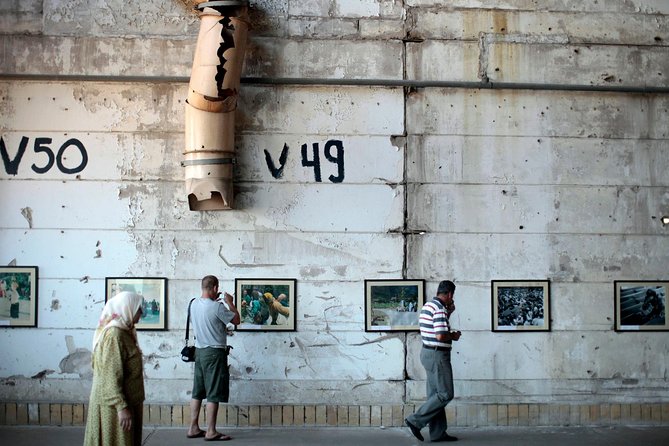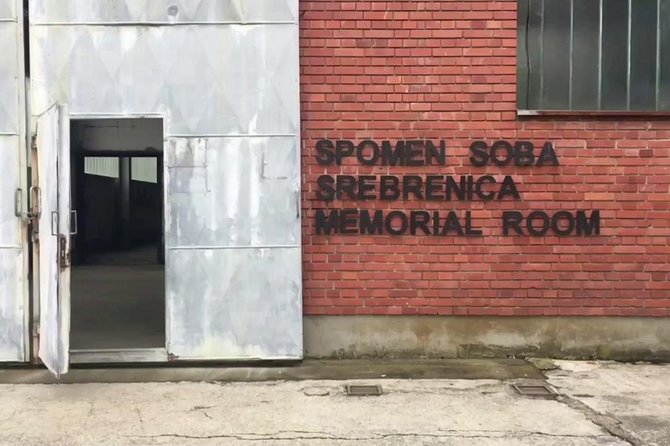The Srebrenica genocide stands as one of the darkest chapters in the history of the Bosnian War. This day tour from Sarajevo provides a profound and thoughtful examination of the tragic events that unfolded in the town of Srebrenica in 1995. Visitors can enjoy the Museum of Srebrenica Genocide, hear firsthand accounts from survivors, and pay their respects at the Srebrenica Memorial Cemetery. Through this guided exploration, the victims’ stories and memories are honored, ensuring their legacy is not forgotten. For those seeking a deeper understanding of this harrowing period, this tour offers a poignant and enlightening experience.
Key Points
- A day tour from Sarajevo provides an opportunity to visit the Museum of Srebrenica Genocide and the Srebrenica Memorial Cemetery, offering a deeper understanding of the tragic events.
- The museum exhibits survivor testimonies, historical artifacts, and multimedia displays that chronicle the chronology and impact of the 1995 Srebrenica genocide.
- The Memorial Room in the museum allows visitors to hear firsthand accounts from survivors, humanizing the tragedy and ensuring the victims are never forgotten.
- The Srebrenica Memorial Cemetery, with over 6,000 grave markers, serves as a solemn reminder of the immense loss of life and a place for reflection.
- The Potocari Memorial Center further contextualizes the Srebrenica genocide within the broader history of the Bosnian War, providing a comprehensive understanding of this dark chapter.
Tragic History of Srebrenica Genocide

The Srebrenica genocide stands as one of the darkest chapters in the Bosnian War, where over 8,000 Bosniaks were mercilessly killed in July 1995.
This tragic event unfolded amidst the backdrop of the Yugoslav wars, a complex web of ethnic tensions and conflicts that had plagued the region.
Despite being declared a UN ‘safe area,’ Srebrenica fell under the control of Bosnian Serb forces, who carried out a systematic and brutal massacre targeting the Bosniak population.
The horrors of Srebrenica serve as a grim reminder of the consequences of unchecked nationalism, and the importance of protecting vulnerable populations in times of conflict.
The scars left by this atrocity continue to shape the region’s history and collective memory.
You can also read our reviews of more tours and experiences in Sarajevo.
Exploring the Yugoslav Wars
Amidst the backdrop of rising ethnic tensions and nationalist sentiments, the dissolution of the Socialist Federal Republic of Yugoslavia in the early 1990s led to a series of brutal armed conflicts collectively known as the Yugoslav Wars. These wars, which involved the secession of several republics, were marked by ethnic cleansing, genocide, and mass atrocities. The complex web of historical, political, and cultural factors that fueled the conflict can be better understood through the following table:
| Cause | Explanation |
|---|---|
| Nationalism | The rise of nationalist movements seeking independence from the Yugoslav federation |
| Ethnic Tensions | Longstanding animosities and resentments between the various ethnic groups within Yugoslavia |
| Power Struggles | Competing interests and power dynamics between political leaders and military factions |
| Economic Factors | Disparities in economic development and resources among the Yugoslav republics |
Understanding the context of the Yugoslav Wars is crucial to comprehending the tragic events that unfolded in Srebrenica in 1995.
Museum of Srebrenica Genocide

Situated within the town of Srebrenica, the Museum of Srebrenica Genocide stands as a somber testament to the atrocities that unfolded in July 1995, when over 8,000 Bosniak men and boys were systematically murdered by Bosnian Serb forces.
The museum provides a rundown of the events leading up to the genocide, chronicling the complex history of the Yugoslav wars. Visitors can explore the museum’s exhibits, which include survivor testimonies, historical artifacts, and multimedia displays that explore the chronology of the massacre.
The museum serves as a space for reflection and learning, ensuring that the victims of Srebrenica aren’t forgotten and that the world remains vigilant against such tragedies in the future.
Survivor Stories at Memorial Room
Visitors to the Museum of Srebrenica Genocide can hear harrowing survivor stories in the Memorial Room, which stands as a solemn space dedicated to the personal accounts of those who endured the 1995 massacre.
Through videos and interactive exhibits, the museum allows survivors to share their firsthand experiences, recounting the horrors they faced and the immense grief they continue to carry.
The Memorial Room provides a platform for these voices to be heard, humanizing the tragedy and ensuring the victims are never forgotten.
Honoring Victims at Memorial Cemetery
After hearing the harrowing survivor stories in the Memorial Room, visitors can now pay their respects at the Srebrenica Memorial Cemetery.
This solemn site serves as the final resting place for over 6,000 victims of the 1995 genocide, their gravestones a stark reminder of the immense tragedy that unfolded in Srebrenica.
Rows upon rows of white marble markers stand as a testament to the lives lost, each one representing an individual whose life was cut short by the violence of war.
Visitors may take a moment of silence, reflect on the lives lost, and honor the memory of those who perished in this horrific event.
Potocari Memorial Center Reflection
The Potocari Memorial Center stands as a solemn reminder of the Srebrenica genocide, serving as a place for visitors to reflect on the immense tragedy that unfolded in July 1995. Here, one can pay respects at the graves of the victims and learn more about the events that led to this devastating massacre. The museum within the center provides a deeper understanding of the chronology and impact of the wars, as well as the personal stories of the survivors. Reflecting at this memorial is a poignant and meaningful experience, allowing visitors to honor the memory of those who lost their lives and contemplate the lessons that must be learned from this dark chapter in history.
| Potocari Memorial Center | Purpose |
|---|---|
| Graves of Victims | Paying Respects |
| Museum | Understanding Chronology and Survivor Stories |
| Reflection | Honoring Memory and Learning Lessons |
| Solemn Reminder | Srebrenica Genocide |
Srebrenica’s Industrial Hub Past
Prior to the Bosnian War, Srebrenica thrived as an industrial hub, known for its diverse range of manufacturing capabilities. The town’s strategic location and abundant natural resources contributed to its prominence as a center of production, making it an important economic driver in the region.
Srebrenica was home to several major factories, including a lead and zinc smelter, a battery factory, and a lumber mill. These industries employed thousands of workers and supported the local economy.
However, the devastating effects of the Bosnian War, including the Srebrenica genocide, brought an end to Srebrenica’s prosperous industrial past. Today, the town struggles to rebuild and recover from the trauma of that dark chapter in its history.
Tour Inclusions and Cancellation Policy
The tour includes an air-conditioned vehicle with WiFi, hotel pickup and drop-off service, bottled water, snacks, and a knowledgeable driver/tourist guide to lead participants through the eye-opening exploration of the Srebrenica genocide. Travelers can cancel up to 24 hours in advance for a full refund, though no refund is provided for cancellations less than 24 hours before the experience.
| Inclusions | Details |
|---|---|
| Transportation | Air-conditioned vehicle with WiFi |
| Guide | Knowledgeable driver/tourist guide |
| Amenities | Bottled water, snacks |
| Pickup/Drop-off | Hotel pick-up and drop-off service |
| Cancellation Policy | Full refund up to 24 hours in advance |
Frequently Asked Questions
What Is the Significance of the Srebrenica Genocide in Bosnian History?
The Srebrenica genocide was a devastating event in Bosnian history, where over 8,000 Bosniak men and boys were massacred in 1995. It’s considered the worst atrocity on European soil since World War II and a dark chapter in the Bosnian War.
How Can Visitors Be Respectful During the Tour?
Visitors can be respectful by listening attentively, speaking softly, and avoiding distractions during the tour. They should also dress modestly and avoid taking photographs in sensitive areas to preserve the solemn atmosphere.
Are There Any Ethical Concerns in Visiting Srebrenica?
Visiting Srebrenica raises ethical concerns as it involves a traumatic genocide. Visitors should approach the site with sensitivity, respect the victims, and engage with the history thoughtfully to honor the lives lost. Proper preparation and guidance from local experts is crucial.
How Can the Tour Experience Be Made More Meaningful?
To make the tour more meaningful, the guide could share personal stories of survivors, contextualize the events within the broader Bosnian War, and provide opportunities for quiet reflection and discussion about the genocide’s impact and lessons learned.
What Support Services Are Available for Survivors and Their Families?
The tour operator provides counseling services and connects survivors and families to local support groups. They also facilitate meetings with guides who are survivors themselves, offering a deeply personal and meaningful experience.
Recap
The Understanding Srebrenica Genocide – Day Tour from Sarajevo provides an in-depth exploration of one of the darkest chapters in Bosnian history.
Through visits to the Museum of Srebrenica Genocide, Memorial Room, Srebrenica Memorial Cemetery, and Potocari Memorial Center, participants gain a profound understanding of the tragedy and honor the victims’ stories.
This tour ensures the memory and lessons of the Srebrenica genocide are preserved for future generations.
More Tours in Sarajevo
More Tour Reviews in Sarajevo
- Sarajevo: Discover Sarajevo Walking Tour with Local Guide
- From Sarajevo: Medjugorje Pilgrimage Full-Day Tour
- Sarajevo: Swimming in waterfalls and discovering Herzegovina
- Sarajevo Sport tour: Olympic Mountains and Stadium Tour
- Sarajevo: Islamic Tour | 500+ years of Glorious Heritage
- Sarajevo: City Tour with Bosnian coffee ritual
Not for you? Here's more things to do in Sarajevo we have recnetly reviewed
- Sarajevo : Private Walking Tour With A Guide (Private Tour)
- Sarajevo: Bosnian & Yugoslav Wars Tour with Tunnel Museum
- Sarajevo: Tunnel of Hope Tour – Survival and Resilience
- From Sarajevo: Olympic Mountains Private Trip
- Sarajevo Jewish Tour
- Sarajevo: Visegrad, Sarkan Eight Railway & Kurstendorf Tour
- Sarajevo: 1984 Winter Olympics Site & Vrelo Bosne Day Trip
- Sarajevo: Crossroads of Cultures – Sarajevo Walking Tour
- From Sarajevo: Full-Day Hike to Lukomir Village
- Sarajevo: Sarajevo City Market, Old Town Food Tasting Tour
- From Sarajevo: Srebrenica Genocide Study Tour
- Sarajevo: Mostar, Konjic, Poitelj, Blagaj & Waterfalls Tour
